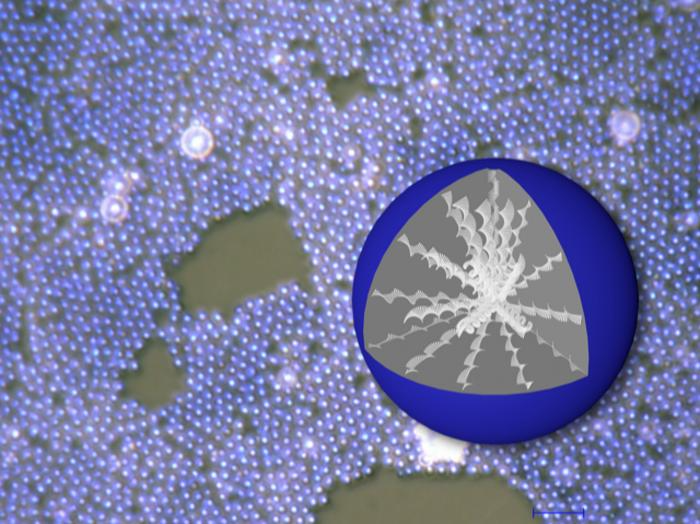Dr. Jialei He of Nagoya University’s Graduate School of Engineering led a research team that devised a technique for processing cholesteric liquid crystals (CLCs) into micrometer-sized spherical particles.

Cholesteric Liquid Crystals (Clcs) Display Unusual Colors Due to Their Unique Molecular Structure and Optical Properties That Lead to The Selective Reflection of Light at Specific Wavelengths. Image Credit: Yukikazu Takeoka tnd Jialei He
CLCs are liquid crystals with a helical structure, which gives them unique optical qualities and the capacity to reflect light selectively.
By mixing spherical CLC particles with commercially available pigments, the researchers created a one-of-a-kind anti-counterfeit QR code that can only be seen through a certain circular polarizer. The findings were published in Advanced Optical Materials.
CLCs demonstrate how nature can be exploited in engineering. What CLCs can do can be seen in the iridescent wings of butterflies or the glossy coating on the exoskeletons of beetles.
Due to their odd colors and qualities that lie between liquids and crystals, CLCs that imitate the units that generate the colors of beetle exoskeletons are made in the laboratory once recognized.
The optical features of CLCs are very beneficial. They have different colors because of their distinct molecular structure and optical capabilities, which cause selective reflection of light at various wavelengths. CLCs are made up of lengthy molecules that repeat in the shape of a helix.
The vertical distance from where one region loops around and repeats itself is known as the ‘pitch’ of the helix.
If the helix comprises close-together repeating units, the liquid crystal has a short pitch and reflects shorter wavelengths of light, emitting blue and violet colors. Those with larger vertical spacing, on the other hand, have longer wavelengths, resulting in red or orange colors.
Further complicating matters, the hue can alter depending on how the spectator is positioned in relation to the helix formed by the molecules that make up the crystal. Therefore, depending on how the liquid crystal is viewed, an endless number of colors are possible.
Researchers create spherical CLC particles in order to better utilize CLCs. Scientists can better regulate the color of these particles because they are spherical and incorporate the helix in a 3D matrix. However, size is a huge issue. Current approaches yield 100-micrometer spherical CLC particles, which are far too big for most applications.
To address this issue, Nagoya University researchers Jialei He (he/him) and Yukikazu Takeoka (he/him) and their colleagues employed a solvent mixture to form spherical CLC particles with a regulated particle size of a few micrometers using a technique known as dispersion polymerization.
It was difficult to discover the new technique since the samples were obtained at room temperature.
The sample testing was a particularly challenging time due to the softness of the samples at room temperature, which is a property inherent to CLCs. Consequently, a considerable amount of effort was required to find an appropriate method to characterize the samples without causing any damage.
Jialei He, Researcher, Nagoya University
Since the curvature of spherical CLCs particles of this size affects the pitch of the cholesteric liquid crystal, the researchers created the particles with a uniform size distribution that are spherical. This is referred to as a monodisperse sphere.
Dr. He added, “During the experiment, we unexpectedly discovered that the particle size of the microspheres significantly influenced the resulting structural color. We could produce a variety of colors depending on particle size. We also found that covering the spherical CLC particles with the polymer polydimethylsiloxane improved the coloration and thermal stability.”
The development of more secure, non-replicable QR codes is one potential use for this research. They can be produced by making use of the CLCs’ chirality property. Chirality is the quality of a substance or item that prevents it from being overlaid onto its mirror image due to an asymmetry.
The color of spherical CLC particles combined with commercially available non-chiral pigments could be used to generate an anti-counterfeiting QR code because CLCs are chiral and have optical activity. Only when a certain circular polarizer is applied, which lets through non-chiral light but blocks chiral light from the QR code, could the code be read.
The development of spherical CLC particles development resulting from this research will provide new possibilities for low-cost structural color functions different from those of conventional color materials. As well as being used a special functional pigment for anti-counterfeiting, it can also be used for other applications that take advantage of the circularly polarized structural color with little angle dependence.
Yukikazu Takeoka, Researcher, Nagoya University
Journal Reference
He, J., et al. (2023) Particle Size Controlled Chiral Structural Color of Monodisperse Cholesteric Liquid Crystals Particles. Advanced Optical Materials. doi:10.1002/adom.202300296.